India – some reflections: I had never had an interest in coming to India but in planning this trip I wanted to see the Taj Mahal, so having traveled so far and making the commitment to be here, it made sense to see more. I am glad we did, it is a wonderful and fascinating country, even in the 100 plus degree heat. Our itinerary actually has us in India for 2 weeks, more than any time in any other country, with stops in Delhi, Agra (to see the aforementioned Taj Mahal), Jaipur, Udaipur and finally we end our stay in India in Mumbai. As I am writing this we have just arrived in Udaipur. I cannot say I know India. I think that Mark Twain said it better than I could ever say it:
The land of dreams and romance, of fabulous wealth and fabulous poverty, of splendor and rags, of palaces and hovels, of famine and pestilence, of genii and giants and Aladdin lamps, of tigers and elephants, the cobra and the jungle, the country of hundred nations and a hundred tongues, of a thousand religions and two million gods, cradle of the human race, birthplace of human speech, mother of history, grandmother of legend, great grandmother of traditions, whose yesterday’s bear date with the modering antiquities for the rest of nations-the one sole country under that sun that is endowed with an imperishable interest for alien prince and alien peasant, for lettered and ignorant, wise and fool, rich and poor, bond and free, the one land that all men desire to see, and having seen once by even a glimpse, would not give that glimpse for the shows of all the rest of the world combined.
It is a diverse country, geographically as well as culturally, with an ancient history and deeply rooted customs, with a population of four times that of the US, over 1.2 billion people, I think a trip of two weeks can barely scratch the surface of such a varied and populous country. What I can do, or try to do, in sharing our pictures, is convey the sense of wonder at the people we have met and the places we have seen.
April 20 Introduction to the Mughals
We met our guide, Virendra, and driver at the airport in Delhi. They will be with us for the next 10 days, through our visit to Udaipur. In India guides are licensed for various parts of the country, V, as he is called, is licensed for the north. We checked into our hotel and then started our visit to a land that I only know from movies like Gandhi and Slum Dog Millionaire. That line always gets a laugh.
Our first stop is Humayun’s Tomb. This was the first garden tomb on the Indian Sub-Continent. Commissioned at his death in 1572 by Hamida Babu Begum, the first wife and chief consort of the Mughal Emperor Humayun. The Mughals were originally from central Asia. They were the Muslim dynasty that ruled Delhi and other parts of India for 300 years from 1526 to 1857. Humayun was the second of the dynasty to rule in Delhi.
The complex encompasses the main tomb of the Emperor which also has within it over 100 graves earning it the name, “Dormitory of the Mughals”. It’s symmetry represents a leap in Mughal architecture, and together with its surrounding garden, typical of Persian gardens it set a precedent for subsequent tombs, such as the Taj Mahal.

This marks the grave at the center of the tomb. 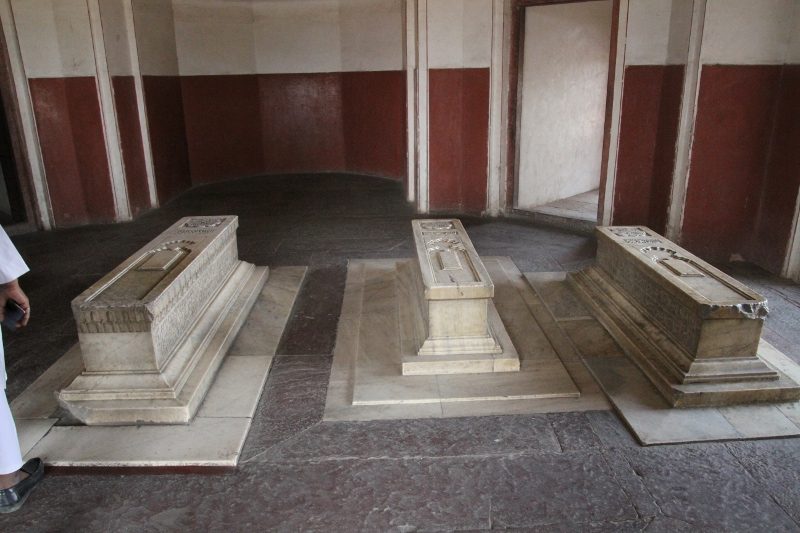
Other graves inside the tomb 
Other graves outside 
Mosque at the side of the tomb 
The gardens
It is a clear departure from the fairly modest mausoleum of prior rulers, such as Isa Khan’s Garden Tomb.


Other graves inside the tomb
This tomb predates Humayun’s tomb by two decades and is the culmination of an architectural style used for royal tombs in Delhi during the Sayyid and Lodi dynasties from the early 15th to the early 16th centuries.
After this we headed back to the hotel for some refreshment and a break from the heat. Dinner at the hotel was a tasting menu of various Indian foods.
April 21 Old Delhi and emotional moments reflecting on the life of Gandhi.
Our morning begins with a rickshaw ride through the streets of the old city. I cannot convey through pictures the cacophony of sounds and the smells, a mixture of scents from flowers, herbs and spices with a hint of animal dung and urine. While Delhi is a modern city with sky scrapers, highways and wealth, it is still a city where old habits and customs are observed so you see the street bazaars, barbers practicing their trade in the street alongside food peddlers and the farmers from the surrounding countryside leading ox carts alongside trucks filled with their produce. This includes chilies, flowers, turmeric and all sorts of foods and spices and household wares and other goods.

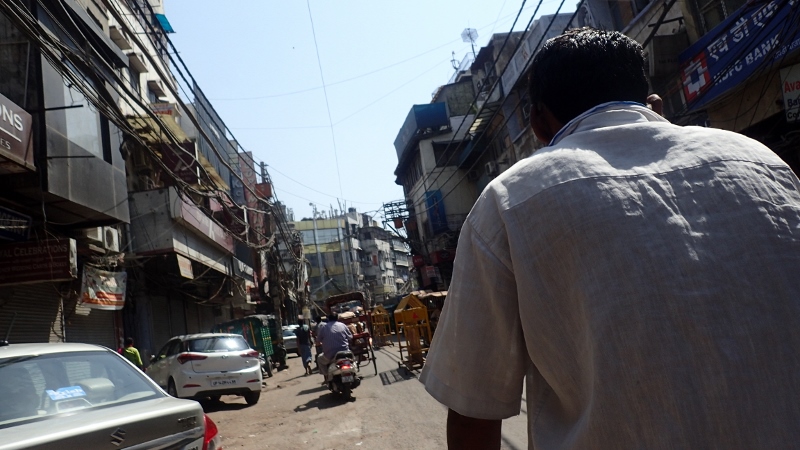

The Sunday Market 
Selling Roses 







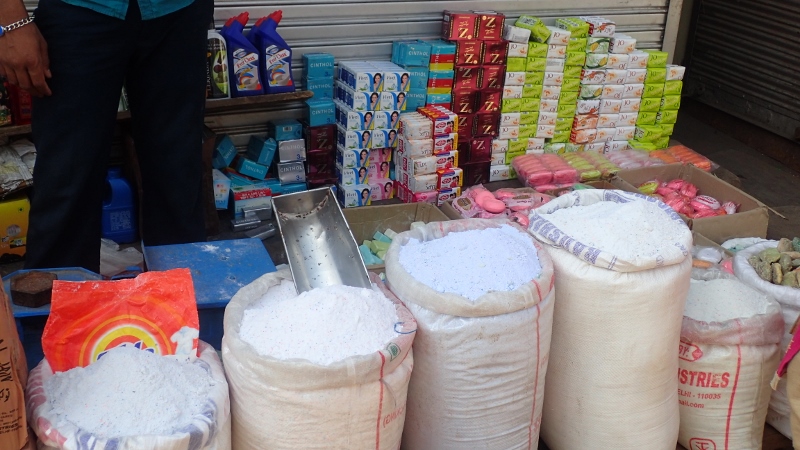


After our visit and shopping at the spice market, our rickshaw took us to the Jama Masjid of Delhi. This is one of the largest mosques in India. Built by Shah Jahan in the middle of the 17th century at a cost of $1 million Rupees. I had always thought of a mosque as a building you entered. I learned that it depends on its location. In this case, the mosque was a large courtyard capable of accommodating 25,000 worshipers. When considering the weather in Delhi, having a mosque for that many worshipers that is “open air”, makes sense. To enter we had to take our shoes off, and Cathy had to put on a shawl that fully covered her.
In the center of the mosque there is a pool of water where worshipers must wash their feet. I noticed young boys throwing lines into the water and wondered why. It turns out, just like every other pool of water, people apparently throw money into the pool for “good luck” and these boys were hoping to fish some out.
We then made our way to a garden area which is the place where high government officials are cremated. Here in a large walled garden sits a large black marble stone and adorned each day with flowered garlands and a memorial flame is the spot where Gandhi was cremated. Along the walkway to the garden are quotes from Gandhi’s writings carved in stone. People are required to remove their shoes to enter the garden. It was a very emotional moment to be in this hallowed space.
From here we visited the house where Gandhi spent the last 114 days of his life in Delhi. This was the house of a local businessman who lent the home to Gandhi. He only used one of the front rooms of the house and would have prayer meeting in the garden each day. Within the house there are memorabilia of his stay, including his bed and spinning wheel. Along the walls there are accounts of his last days as well as some history of his work in South Africa and his involvement with the independence movement. There is a pathway with footprints showing his last steps up to the place where he was assassinated.


Gandhi’s room 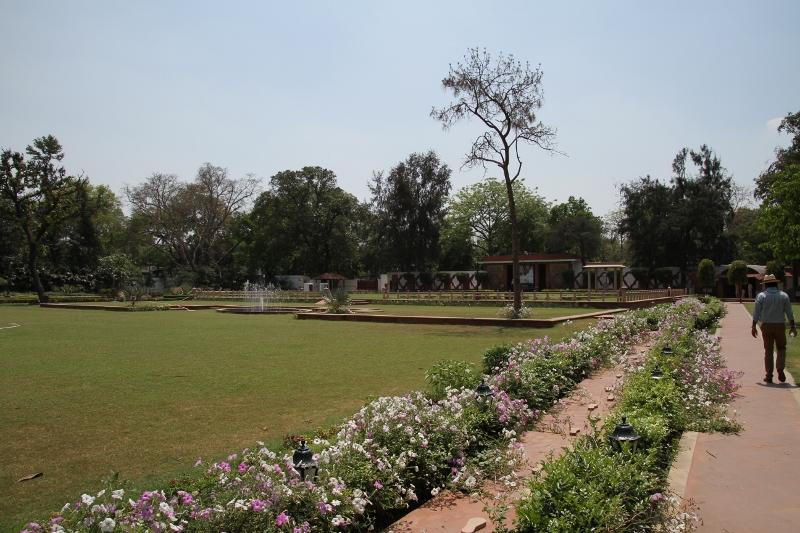
The gardens 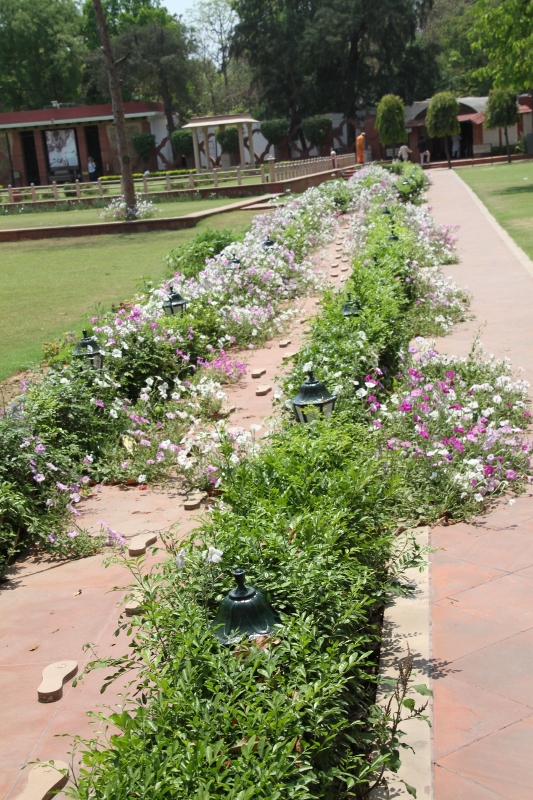
The footpath 
The spot where Gandhi was assassinated.
Our next stop was to see the India Gate, a war memorial as well as the Presidential Palace and other government buildings built by the British as the center of government. The Presidential Palace was the home of the British Viceroy and has 330 bedrooms. It is flanked by two identical looking buildings that house government offices for the Ministry of Finance and War.
We ended the day with dinner at the home of the Managing Director of Alluring India, our tour operator in India, Deepak Modgill. This was a pleasant interlude to meet his family and have a traditional Indian dinner at his lovely home.
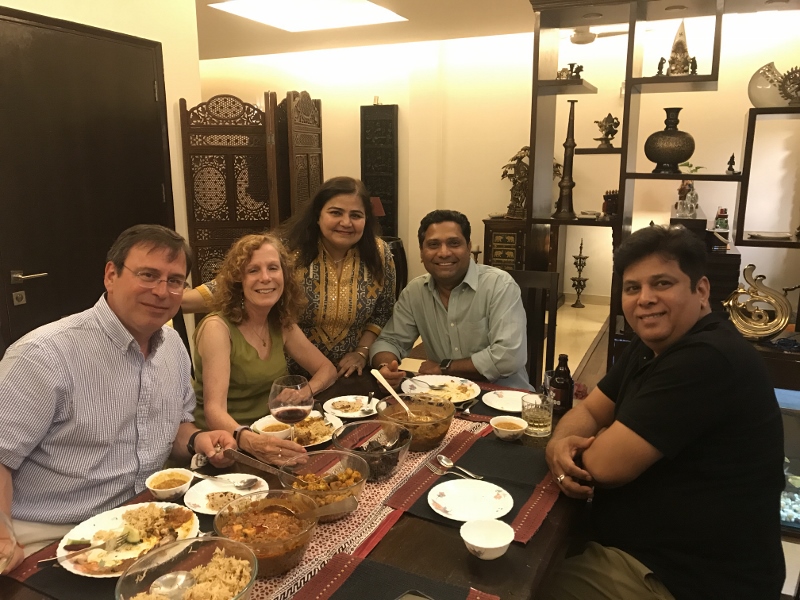
April 22 South Delhi and a Gurdwara
In the morning we headed to South Delhi to visit some the site of some tombs and constructions of the first Mughal rulers. When Cathy was in Delhi some 20 years ago, she was startled by the presence of cows in the streets. Today you do not see cows in the newer parts of the city, but here in South Delhi we did see the cows roaming the streets. Cows are sacred animals in India, and it is against the law to kill them, the source of some recent conflicts in some areas. So, when a cow is old and cannot give milk or too old to work, families will just turn them loose. Often you see old men or women selling bits of greens for people to buy to feed the cows, this is charity and brings good Karma. But I digress.
We entered the Qutb Complex. There are several monuments within the complex, the most striking being the Qutub Minar. At a height of 72.5 meters, it is the tallest brick minaret in the world and is also one of the finest examples of Indo-Islamic architecture. Its construction was started at the end of the 12th century by Qutbuddin Aibak of the Mamluk dynasty It is built of red and buff sandstone and has verses of the Quran carved in it.
Another of the monuments here that has a storied history is the Iron Pillar. The pillar has attracted the attention of archaeologists and materials scientists because of its high resistance to corrosion and has been called a “testimony to the high level of skill achieved by the ancient Indian iron smiths in the extraction and processing of iron”. The pillar weighs over 6,000 kg (13,000 lb) and is thought to have been erected in what is now Udayagiri and reused by one of the Gupta monarchs in approximately 402 CE, though the precise date and location are a matter of dispute.
Other monuments here include the Quwwat-ul-Islam Mosque also known as the Great Mosque of Delhi. It was the first mosque that was build in Delhi after the Islamic conquest of India. And finally, the 13th century tomb of Iltutmish.
Our next stop was at a Sikh temple or what is called a Gurdwara. The outside of the Gurdwara is white. The Sikhs tithe, and those Gurdwara that are wealthier, it will be sheathed in pure marble. The inside, which I could not photograph, is colorful and, again for those that can afford it, the walls will be covered in gold. The Sikh religion has its origin in the 15th century among farmers of the Punjab region of northern India. Though one of the youngest of the major world religions, it is the fifth largest organized religion, as well as being the world’s ninth largest overall religion. The Sikhs believe in equality of all humankind, engaging in selfless service striving for justice for the benefit and prosperity of all. During our visit we could see this in action. On the temple grounds there is a huge, and I mean huge, kitchen where volunteers come to cook food for any who come.

The Gurdwara 
Entrance 

A pool for washing feet before entering the Gurdwara 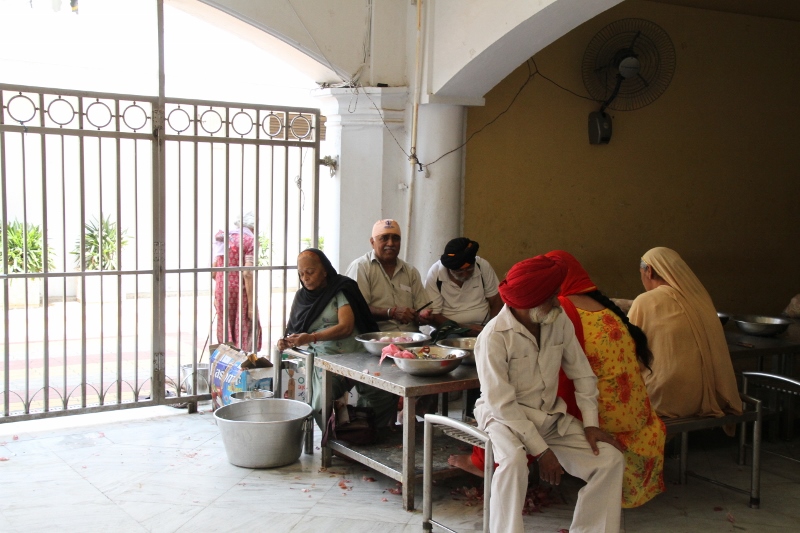
Volunteers preparing food 
Supplies for a days meal 
Large vats in the kitchen for lentils 
Pouring out the lentils 

Cooking the bread 
Helping make the bread
After our visit to the Gurdwara, we returned to the hotel for some rest. We had dinner with Anupam a former colleague of Cathy’s from her days at IBM and his wife Manju. Dinner was at a former British club.

Tomorrow we leave for Agra.




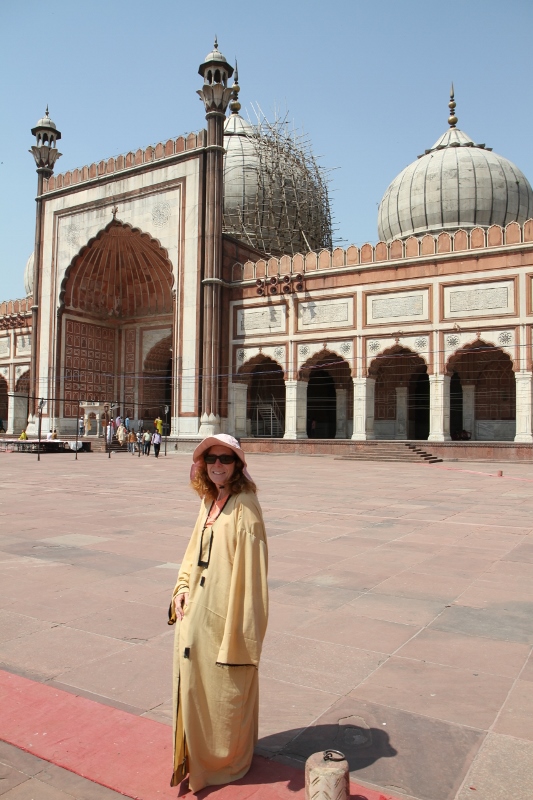


















Absolutely amazing. Was never a place I wanted to visit, but this really changes you mind.
Wow what a journey you two are on. Truly life changing. I am enjoying watching all of it.